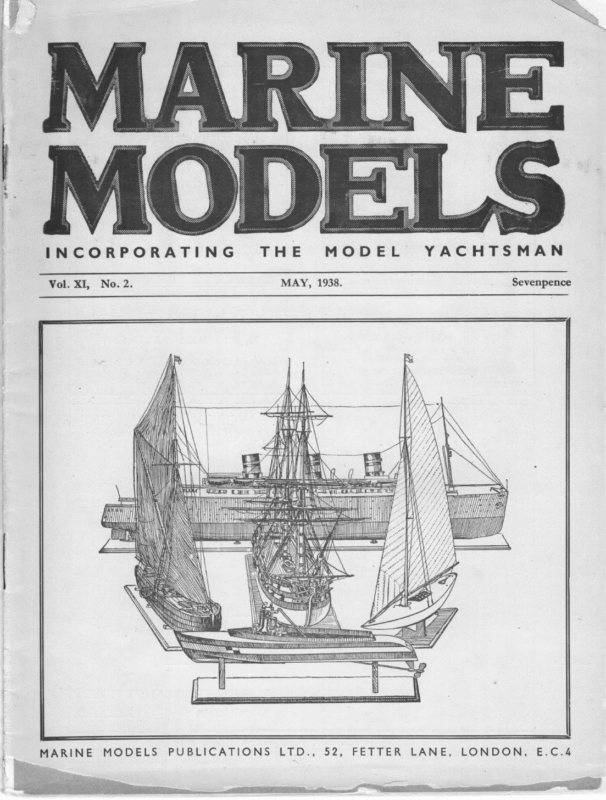MMHHHAHNHHMWMAAY SMWUAA, “GY Zi.y/” MAG, titly, Gy, Wdist lA MOOS Y Z%%ZZZy A SMO WO e fy, bhVMS TNMB Z Z Z 4Z INCORPORATING at y ehb 1,Wt SSSS Ro Wit ls Wa SN Z yett ttt W “i, MARINE YWy SS RAs RAAIUHAAMQN SSSSSSs Vol. XI, % %y THE YACHTSMAN Sevenpence MAY, 1938. No. 2. MODELS MODEL PUBLICATIONS LTD., 52, FETTER LANE, – ides tpn ee LONDON, E.C.4
EVERY JOB NEEDS A se ecearce | | FINEST SOFT PINE f With Specially selected for Renewable Model Boat Building. Hook-shaped » Scraping Edges. ‘ All thicknesses from ad Hooks 4” to 3”, widths up to 24” extended for Corner Scraping. ALSO ; SAVE TIME— SIMPLIFY WORK Prime Honduras Mahogany Nothing better for superior smoothness and refinishing. FOR RE-SHARPENING CHETHAM TIMBER Co. Ltd., SKARSTEN SCRAPER FILE Sold at Ironmongers, Paint Shops, 70, FINSBURY Merchants, and Ships’ Chandlers, or write to ; — SKARSTEN MFG. CO. | WELWYN GARDEN CITY R Y LA -_ PAVEMENT, Builders’ LONDON . HERTS. 4 D E.C.2 METROPOLITAN 7418 THE WORLD’S BEST MARINE VARNISH AND ENAMEL oes OGLOSO Superfine White Enamel RYLARD Racing Bottom Paint KLEEROFF Paint and Varnish Remover. LLEWELLYN RYLAND LIMITED, BIRMINGHAM – – When replying to Advertisers please mention MARINE MODELS. ENGLAND
INCORPORATING THE MODEL YACHTSMAN Vol. XI,No. Published on the Seventh of each Month 2. May, 1938 EDITORIAL E recently received a copy of the / 1938 Year Book of the M.Y.R.A. of America, edited by Chas. H. Farley. In. addition to lists of Officers, Fixtures, and Affiliated Clubs, this contains articles by the Editor, John Black, E. L. Cheney, and Fred L. Pigeon, besides a folding plate giving the burgees of all the 62 affiliated clubs in colour. The number of affiliated clubs shows the growth of the sport in the States, and the Year Book gives particulars of these, including Year Organised, Joined M.Y.R.A.A., Number of Members, Pond or Skiff Sailing, Models in Commission, 1937, and New Models Registered 1937. A list of some 20 unaffiliated clubs is also included—surely a strong inducement to these to come forward and join the national movement. The Editor of the Year Book is to be congratulated, and it does great credit to the M.Y.R.A.A. This Association evidently spends more on printing than our own M.Y.A., but the dues are higher, being $10 per club. The growth of the sport in America is a worthy return for the time and money expended. The particulars of clubs show that only nine are still confined to skiff sailing, giving an idea of the number of new lakes constructed in recent years. As regards classes sailed, only the A-class and M-class (Marblehead) are recognised. There were 210 A-class and 739 M-class in commission in 1937, and new registrations numbered 112 A-class and 293 Mclass, giving totals for the end of 1937 of 322 A-class and 1,032 M-class. All clubs had M- class yachts, and eight had no A-class boats. The American claims -made for the Marbleheads as a means of fostering the sport were evidently not exaggerated. While on the subject of this class, readers are reminded that the Ryde M.Y.C. are again organising the British M-class Championship on June 25. We may mention that this class is taking on very strongly with one of our largest Metropolitan clubs, the M.Y.S.A., who are dropping the 36in. Restricted class in its favour. We are glad to welcome Mr. Kenneth G. Williams, of Bournville M.Y. & P.B.C., as a contributor to these pages. The first part of his article on Carburettors for Model Speedboats appears elsewhere in this number of MarRINE Mope.s. The performances of his model speedboat “* Faro,” 30 c.c. class, will be familiar to all readers of this Magazine. Model speedboat men will be sorry to hear that Mr. L. S. Pinder has recently had to undergo an operation. He is now out and about again, but complete recovery will take some time, and he does not expect to take an active part in racing for some time yet. We trust that before the season is over we shall once again see “ Rednip”’ putting up her usual excellent performance. The coveted 50 m.p.h. seems within reach this season, and the great question is: Who will have the honour of being the first to exceed it? The season is yet young, and we shall probably have the answer to this question before many months elapse.
26 MARINE SHIPS’ MODELS ANCHORS By A. P. IsarD, A.M.I.Mech.E. (Continued from page 3.) hh HIS series of articles on ground tackle Newcastle-on-Tyne, for very considerable information upon these anchors, which are to be found aboard all types of ships, both big and small. It is interesting to note that the original firm was founded a few years before the patents were granted—that is, in 1871. The firm has very kindly supplied the writer with genuine drawings, which are faithfully reproduced. These drawings are obviously of great value to the model-maker, and readers can no longer make excuses if their models are equipped with ground tackle perhaps not quite accu- throughout the ages started in Vol. X, No. 7, of MARINE MODELS, the issue for October, 1937, and is now rapidly coming to an end. We have studied the history and evolution from the earliest records of this interesting subject up to about the middle of the last century; it now only remains to consider modern apparatus and its applications to the enormously heavy modern ships that have to be steadied and held, not only in considerable tide-ways, but under the severest conditions likely to be met with. Doubtless the preceding notes will not have interested vastly those model-makers whose interest lies mainly in modelling modern ships; nevertheless, it is quite necessary to deal with the subject as a whole, since model-makers are makers of models of all sorts, ages and conditions. The stockless anchor is in universal use today, and in 1873 the well-known Wasteneys Smith’s stockless anchors were patented. The writer is very much indebted to Messrs. Wasteneys Smith & Sons, Ltd., of rate in detail owing to difficulty in obtaining authentic information. It will be noticed that the drawings are not dimensioned, since these would depend upon the size of vessel the particular anchors were intended for; they have been carefully reproduced so that readers can follow them easily, and scale down to suit the model being made. It will only be necessary to fix upon this scale, and then keep all details strictly in proportion. J The naval type anchor, which has been | y = | \ 7 IE cf cu \ fg = = > ~-— ——}—. —- c





